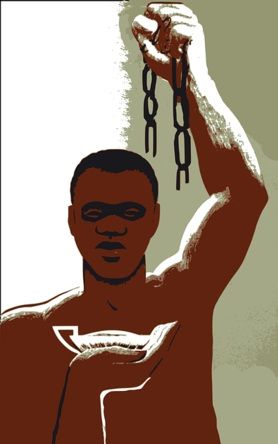“Nanny Town became the center of the resistance to British plantation imperialism in Jamaica, the headquarters from which the maroon bands almost succeeded in driving all of the imperialists from the island together”
Maroon the Implacable, p32
Maroon War Illustration: This image from 1834 depicts a battle between Jamaican Maroons and British soldiers. After two wars in the 18th century, the British signed treaties with the Maroons, enabling them to remain free and self-governing until slavery was abolished.
ILLUSTRATION BY UNIVERSAL HISTORY ARCHIVE, GETTY IMAGES, British Colonel Guthrie and Jamaican Maroon Colonel Cudjoe exchanged hats as a sign of friendship and sign the Treaty of 1738 ending the First Maroon War in 1803 engraving with modern color.
Illustration of British camp
Illustration of British Soldier on Maroon Terrain
Maroon Town Illustration
“Maroon successes in the Maroon Wars are attributed to their military leaders, most notably Granny Nanny, the heroine who is reputed to return British ammunition to their military with her backside resulting in British deaths in the wars…”
Kenneth Bilby, True-Born Maroons (Kingston: Ian Randle Publishers, 2006). Carey Robinson, The Iron Thorn: The Defeat of the British by the Jamaican Maroons (Kingston: LMH Publishing, 1993
Treason: The Maroon Treaty
Maroon Wars lasted from 1655 until 1738, and the end of the war was marked by a treaty that guaranteed the Maroons freedom from slavery, many acres of land to support their communities, and general autonomy. In return, they had to return runaway slaves to their plantations and put down slave rebellions.
They formed five communities: the largest being the Trelawny Maroons who were deported to Nova Scotia, Canada, and then to Sierra Leone, the Accompong, the Moore Town Maroons, and Charles Town and Scott’s Hall Maroons.
The Jamaican government tried to destroy the Maroon communities after slave emancipation and hoped to assimilate the Maroon populations with the rest of the African heritage population to re-enforce them to work on plantations and deprive them of land, continuing plantation labor.
However, the historical record shows that the Accompong Maroons used new forms of resistance to ensure that their communities and treaty stayed intact and gained additional landholdings, contrary to the law.
Cudjoe, who was named either Kojo or Kwadwo was born in Accompong Town, Jamaica in 1690. Cudjoe was instated as the front-runner of the Leeward Maroons and fought the the previous Madagascan leader of the Leeward Maroons – and won by killing him.




Recent Comments